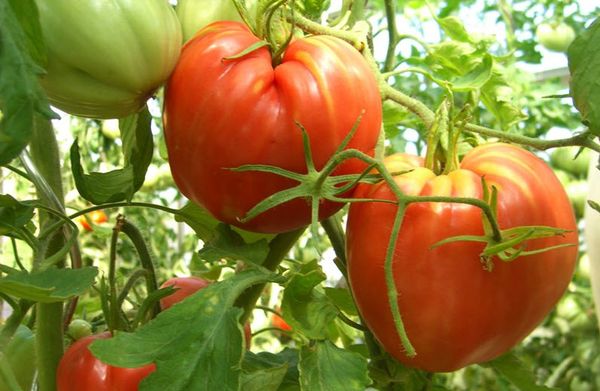Modern summer residents and gardeners are lost when it comes to choosing varieties of tomato for their site. Everyone is trying to get a good harvest, while not particularly wasting. Tomato Cardinal is one of the first places among the most popular varieties.
Table of contents
- Characteristics and description of the tomato Cardinal
- The merits of the variety
- Cardinal Disadvantages
- The choice of location and soil for planting
- Features of planting seedlings
- Conditions for the care of crops
- How and when to transplant tomatoes in open ground
- Grade care after transplanting
- The most frequent diseases and pests
Characteristics and description of the tomato Cardinal
Description, which will help to learn about the main features of the plant
- Variety self-pollinated, therefore suitable for growing both in open ground and protected.
- The fruits have a bright pink and bright red color and a pronounced aroma and taste. Fruits are formed on the brush, which can be placed up to 5-7 fruits.
- Variety is able to bear fruit several times per season. The weight of the fruits of the first fruiting reaches 850 grams, but the subsequent yields are much less. For the season you can collect from the bush up to 4.5 kg (with sq.m. - 16 kg).
- With proper planting and care, the first fruits really get in early July. Tomatoes tolerate transportation well and are stored for a long time without losing the main properties.
- Tomato is a hybrid and is considered medium early a grade (from the first shoots before emergence of fruits pass 110-120 days).

The variety has many advantages that help to find more and more lovers of such tomatoes.
The merits of the variety
What is the Cardinal attracted gardeners?
- The main advantage of the variety is its versatility: it is ideal for use both in its raw form and for all types of preforms. Also, the Cardinal is suitable for growing in greenhouses and open ground.The landing site affects only the height of the bush itself: in the open field they can reach a maximum height of 1.5 meters, and in greenhouses - up to 2 meters.
- The fruits are different special taste and juiciness.
- The cardinal is very rarely affected by diseases and pests.
- After sowing, the seeds quickly sprout. There is a good quality planting material.
- The variety is resistant to bad weather conditions.
Cardinal Disadvantages
There are not many minuses and their role is not critical for growing, but rather some particularities.
- To achieve high yields of the bush requires timely formation.
- Since the height of the bush can reach 1.5 - 2 m. It is better to tie it up.
- Fruits of the first fruiting not suitable for pickling in banks whole because of its large size.
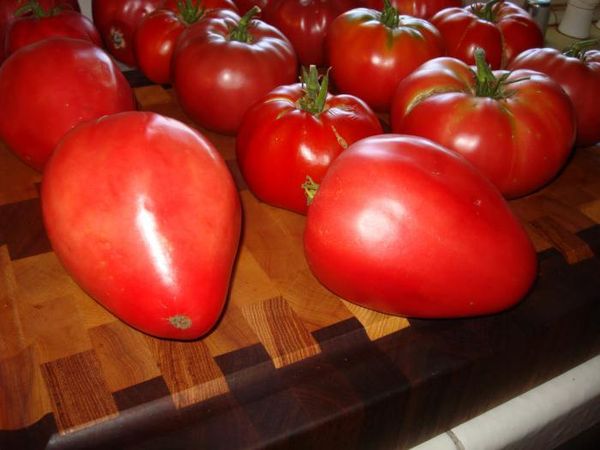
The choice of location and soil for planting
It is not necessary to plant tomatoes in the garden, where eggplants, peas, peppers, tomatoes and potatoes were previously grown. But at the place of growth of onions, cabbage, beans, even need to plant tomatoes.
Tomatoes Cardinal love nutrient light soil. As the soil for planting, you can use sod or garden soil mixed with humus. Adding superphosphate or wood ash will positively affect the growth and development.
Features of planting seedlings
Tomato seeds are planted in small containers, watered and covered with foil, creating a greenhouse effect. The ideal temperature for growing seedlings is 24-26 degrees. The best time to land will be March, April.
Before planting, the seeds should be decontaminated by placing them in a light solution of potassium permanganate for 25-30 minutes. After that, rinse under running water. Seeds during planting are deepened by 1.5-1.7 cm.
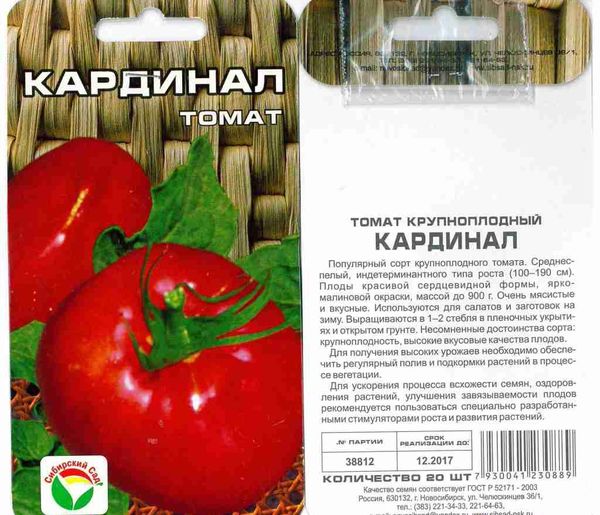
Conditions for the care of crops
- Location and lighting. After the first sprouts appear, the boxes are taken out to the place where the sunlight will be available for the sprouts. They should not be exposed to direct sunlight. If there is no such place for seedlings in the room, you can use additional lighting.
- How to water. For irrigation and humidification of the air is better to use a spray, and not a watering can. Overabundance of moisture is not allowed, it provokes root decay. Watering is better at the beginning or end of the day.After the seedlings are first grated, it can be mulched. In the same period, transplant each sprout into a separate peat cup, with which it is possible to plant plants directly into the ground over time.
- Is it worth it to fertilize. Top dressing is one of the important processes on which the quality of the crop and the health of the plant depend. They are especially relevant at the stage of formation of seedlings. To do this, use complex feeding.
- Hardening seedlings. Acclimatizing the seedlings to new temperature conditions is necessary before planting into the soil. For some time, young seedlings are taken out in a cool place, in which there is no direct sunlight and drafts.
How and when to transplant tomatoes in open ground
Planting of seedlings in open ground is carried out after the threat of frost will pass (the end of May - the beginning of June). The soil in which the young seedlings will be transplanted must comply with the following characteristics: necessarily fertilized with an earthy mixture with peat and humus, it is preferable to choose an area with diffused lighting.
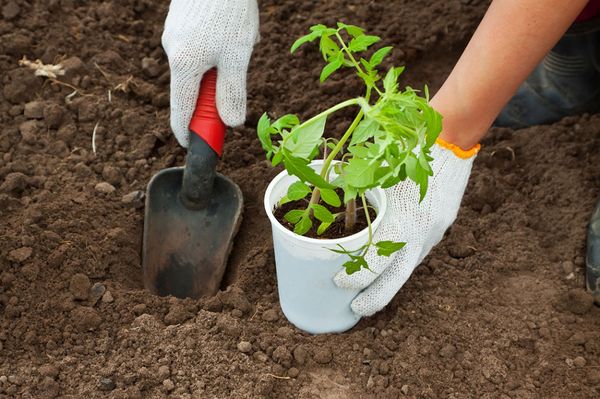
In order for the plants to produce a full-fledged crop, one must adhere to the distances between them when planting. Better not plant them closer than 70 by 70 cm. So that they are better rooted in the new place, after planting they pour only with warm water and cover themselves with a film in order to create a greenhouse effect for a while.
Grade care after transplanting
Care of tomatoes Cardinal is not difficult, but you should definitely fulfill all the conditions.
- Watering requires moderation. Waterlogging will destroy the plant. For watering (it is advisable to do it only under the bush) to use warm and soft water. Especially in the first time after transplantation.
- Tomatoma Cardinal will not interfere 2-3 one-time feeding per season complex fertilizers.
- Ground treatment. Mandatory are timely weeding and loosening soil (at least 2 times a month). This will not only save the area from weeds, but will also control the level of heat and moisture in the soil. In the period of active growth of the bush and do hilling. The first time such procedure is carried out in 3 weeks after planting, and the next - in 3 weeks.
- Mulching is not an obligatory procedure, but it can relieve gardeners of several problems at once: no need for frequent loosening and weeding, the risk of disease and pests is reduced, additional protection for the roots. The procedure helps to increase the yield, saturates the soil with the necessary microelements. Most often, dry mulch is used for mulching.
- Garter is obligatory for this variety.This is required by the height of the plant. Twine, tree creeper, pole or self-made rods are suitable for the garter.
- How to shape a bush? It is important to conduct a stew of Cardinal varieties of tomatoes. Only the lower leaves or side shoots are pruned. The tallest plants need pinch point growth.
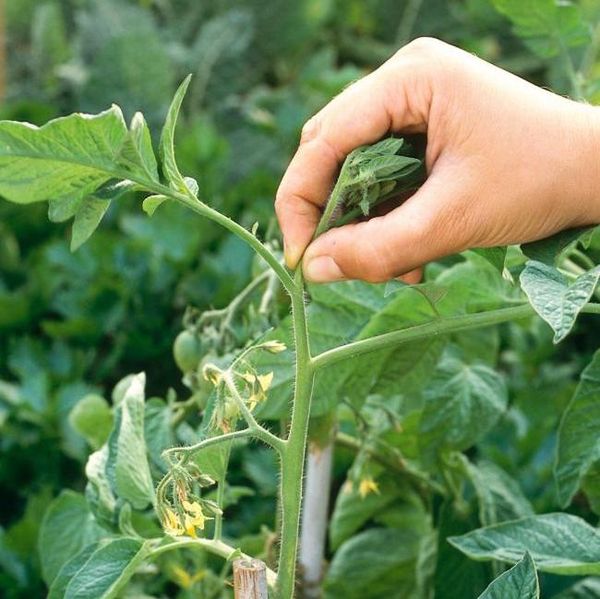
The most frequent diseases and pests
The main reason for the defeat of Cardinal diseases and pests is improper care of tomatoes. Some mistakes can lead to the death of the plant. As a result, fungi appear. To protect the plant from damage, you need young seedlings treated with fungicides.
Among the pests are the most dangerous mold, spider mite, aphid.At the first attacks of pests, tomatoes are treated with high-quality insecticides.
Grade Cardinal - a culture that has gained popularity among gardeners because of the high yield and resistance of the plant. Observance of elementary rules will allow to receive tasty and juicy fruits.
